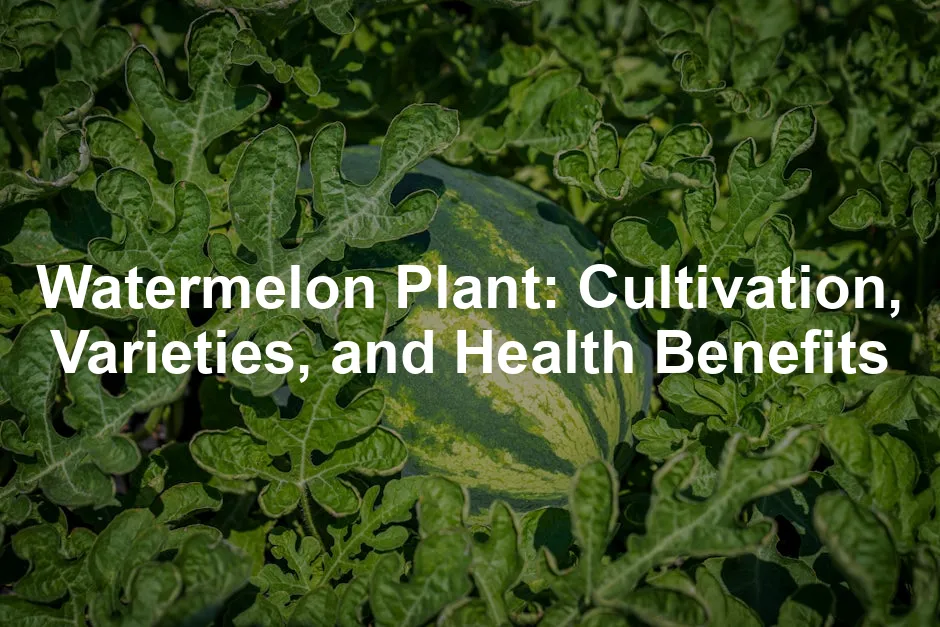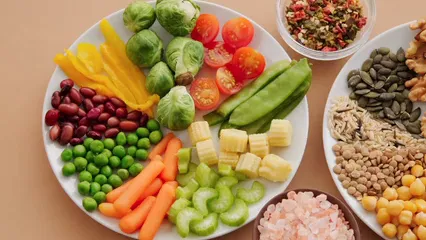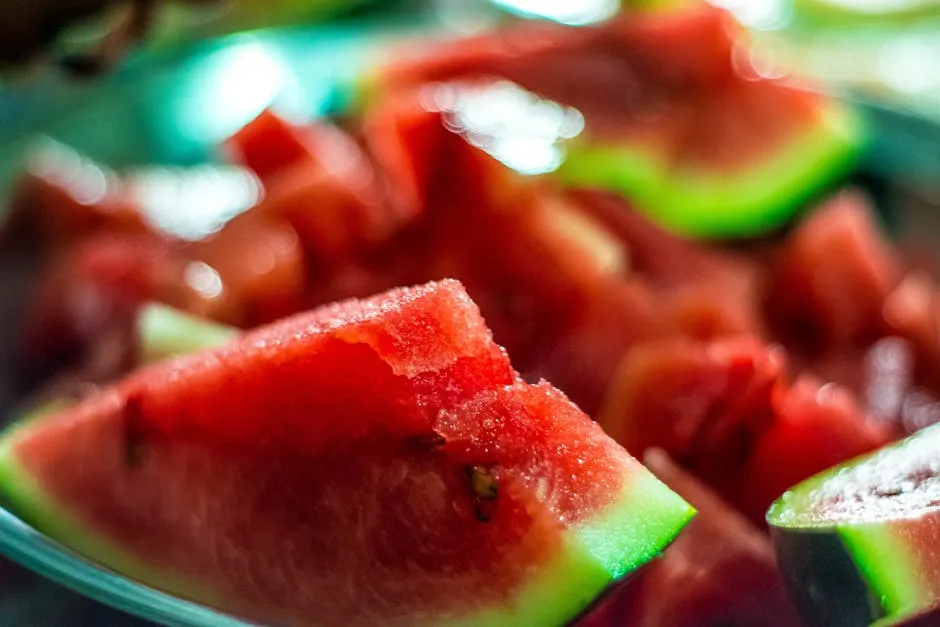

Watermelon Plant: Cultivation, Varieties, and Health Benefits
Introduction
Have you ever wondered about the watermelon plant (Citrullus lanatus)? This vibrant fruit is more than just a summer treat. It plays a crucial role in agriculture and cuisine worldwide. Watermelon is especially popular during hot months, providing a refreshing burst of hydration and sweetness. In this article, we’ll cover its cultivation, diverse varieties, culinary uses, and impressive health benefits.
Summary and Overview
Get ready to learn all about watermelon plants! We’ll explore their origins, belonging to the Cucurbitaceae family. This fascinating plant features unique characteristics, including its sprawling vines and large, juicy fruits. Watermelons are packed with nutrients and have versatile culinary applications. Stay tuned as we dive deeper into how to cultivate this beloved fruit and the various types available.
Cultivation of Watermelon
Ideal Growing Conditions
Growing watermelon requires specific conditions for optimal success. These plants thrive in warm climates, ideally where temperatures exceed 25°C (77°F). The best climate zones include regions with a long growing season, typically lasting about 70 to 90 days. When it comes to soil, watermelon prefers well-draining, sandy loam with a pH range of 6.0 to 6.8. Nutrient-rich soil promotes healthy growth, so incorporating organic matter helps. Adequate drainage is crucial to avoid waterlogged roots, which can harm the plant. Check with your local agricultural extension for tailored advice on growing watermelon in your area.

To ensure your plants are thriving, consider using a Soil pH Tester. This handy tool will help you determine if your soil is in the right range for optimal watermelon growth. A well-balanced pH can make all the difference between a mediocre harvest and a bountiful one!
Planting Techniques
Planting watermelon involves a few key techniques to maximize yield. Begin by sowing seeds about 1 inch deep, spaced 36 to 42 inches apart. If transplanting seedlings, ensure they are well-established before moving them outdoors. Direct sowing is also popular, especially in warmer climates. Don’t forget about pollination! Watermelon plants have male and female flowers, and successful fruiting relies on bees and other pollinators. Generally, watermelon seeds germinate in 5 to 10 days, so patience is essential. Have you tried planting watermelon seeds? Share your experiences in the comments!
For effective planting, consider exploring the best companion planting techniques for vegetable gardens 2024 to enhance your watermelon yield.
Watering and Fertilization
Watering is essential for healthy watermelon growth. During the seedling stage, keep the soil moist but not soggy. As the plants mature, reduce frequency to every 3-4 days. Once fruit begins to develop, increase watering to 1-2 times per week, depending on rainfall.
Choosing the right fertilizer is also crucial. Organic options, like compost or well-rotted manure, provide nutrients gradually. Synthetic fertilizers, however, can deliver nutrients quickly. Each has its benefits, so consider your gardening style. To make your life easier, you might want to try out some Organic Fertilizer for Vegetables. It’s the gardener’s best friend, helping your plants flourish without the added chemicals!
Watch for signs of overwatering, such as yellowing leaves or root rot. Nutrient deficiency shows up as stunted growth or discolored leaves. On average, each watermelon plant consumes about 1-2 gallons of water weekly.
Feeling adventurous? Try experimenting with organic fertilization methods to see how they impact your harvest!

Health Benefits of Watermelon
Nutritional Profile
Watermelon is not just delicious; it’s also packed with nutrients. A 100-gram serving offers about 30 calories, making it a low-calorie snack. This fruit is about 91% water, which helps keep you hydrated. It contains essential vitamins like Vitamin C, which boosts your immune system. Potassium is another key mineral present, aiding in heart health and muscle function.
One standout feature of watermelon is its antioxidants, particularly lycopene. This compound gives the fruit its vibrant red color and may help reduce the risk of certain diseases, including cancer. Studies suggest that lycopene can lower oxidative stress and inflammation in the body.
Incorporating watermelon into your daily diet is an easy way to enjoy its numerous health benefits. Whether you eat it fresh or blend it into a smoothie, you’ll be nourishing your body deliciously. Speaking of smoothies, why not invest in a Smoothie Blender? It’s a great way to whip up delicious, nutritious drinks packed with watermelon goodness!

Culinary Uses
Watermelon is incredibly versatile in the kitchen! You can enjoy it in various ways, from refreshing salads to fruity smoothies. One popular recipe is a watermelon salad, combining feta cheese, mint, and a drizzle of balsamic glaze. It’s a delightful summer dish that’s both tasty and visually appealing. Why not enhance this dish with some Feta Cheese Crumbles? They add a salty contrast that complements the sweetness of watermelon beautifully.
Don’t forget about the rind! Many people toss it aside, but it can be pickled or stir-fried for a crunchy snack. Watermelon seeds are also a nutritious option; they can be roasted for a crunchy topping or ground into flour for baking. If you’re interested in trying your hand at pickling, grab some Pickling Spice Mix to get started!
Globally, watermelon shines in different cuisines. From Southeast Asian desserts to Mediterranean dishes, its sweet flavor and juicy texture enhance countless recipes. Watermelon consumption has been on the rise, thanks to its health benefits and culinary flexibility.
What’s your favorite way to enjoy watermelon? Share your recipes in the comments!

Symbolism and History
Watermelon has deep roots in various cultures. Its history dates back to ancient Egypt, where it was cultivated around 4,000 years ago. Archaeological discoveries reveal wild watermelon seeds in Libya, dating to about 3,500 BC. This fruit spread from Africa to India by the 7th century and then to Europe, thanks to traders and explorers.
In many cultures, watermelon symbolizes abundance and hospitality. In China, it’s common to serve watermelon during celebrations, representing good fortune. Similarly, in the Southern United States, it evokes community gatherings and picnics, often seen in art and folklore.
Watermelon has made its mark in literature and art, too. From poems celebrating summer to paintings depicting lush fruit bowls, it represents joy and refreshment. The fruit’s vibrant colors often symbolize life and vitality, making it a favorite in various artistic expressions.
What cultural stories or experiences do you have with watermelon? Reflect on how this beloved fruit has woven itself into your life or traditions.

Watermelon Festivals and Events
Around the globe, watermelon festivals celebrate this juicy fruit with enthusiasm. One of the most famous is the Watermelon Festival in Hope, Arkansas, attracting over 20,000 attendees each year. Here, visitors enjoy activities like seed-spitting contests and watermelon-eating challenges.
In the small town of Cordele, Georgia, the Watermelon Days Festival showcases local culture, featuring live music and art displays. This event celebrates the harvest and brings together community members, fostering unity and fun. If you’re planning a picnic to enjoy some watermelon, don’t forget to bring along a Picnic Basket Set to keep your treats fresh!
Festivals often include unique traditions, such as the Watermelon Festival in Catania, Italy, where locals create intricate carvings and sculptures from the fruit. Such events encourage creativity and showcase the fruit’s versatility.
Have you ever attended a watermelon festival? If not, consider visiting one nearby to join in the fun and share your experiences with friends and family!

FAQs
What is the best climate for growing watermelon?
Watermelon thrives in warm climates with temperatures above 25°C (77°F). Ideally, it needs full sun and well-drained soil for optimal growth. Look for regions with a long growing season for the best results.
How long does it take for watermelon to grow?
Typically, watermelon takes about 70 to 90 days from planting to harvest. The growth stages include germination, flowering, and fruit development. Timing may vary based on the variety and growing conditions.
Can watermelon seeds be eaten?
Yes, watermelon seeds are edible! They can be roasted for a crunchy snack or ground into flour. They are nutritious, containing healthy fats and protein, making them a great addition to various dishes.
What are the differences between seedless and seeded watermelons?
Seeded watermelons contain black seeds, while seedless varieties have small, undeveloped seeds. Seedless watermelons are often sweeter and easier to eat, but both types require careful pollination for fruit development.
How can I tell when a watermelon is ripe?
To check ripeness, look for a uniform shape, a dull skin, and a creamy yellow spot on its underside. Tapping the watermelon should produce a deep sound, indicating juiciness.
Please let us know what you think about our content by leaving a comment down below!
Thank you for reading till here 🙂 And remember, if you’re planning a summer outing, grab a Beach Umbrella to keep you cool while enjoying your watermelon!
All images from Pexels



